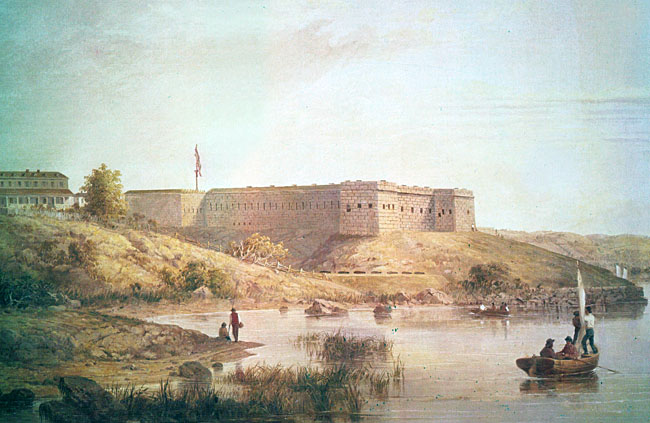Fort Trumbull
Today, Fort Trumbull. The University of Houston's College of Engineering presents this series about the machines that make our civilization run, and the people whose ingenuity created them.
Our east coast is studded with a kind of low-lying, star-shaped fort that sprouted at the turn of the 19th century. And a new breed of rifled naval guns soon made them obsolete. The sturdy stone walls of those attacked in the Civil War quickly became rubble. The others survive intact as a staple of America's eastern shores. Two lie in Boston Harbor; they dot the coast of Maine.
And there's Fort Trumbull, sitting on a bulge in the mouth of the Thames River Estuary just south of New London, Connecticut. New London has been an especially important port since the Estuary is one of the deepest on the Atlantic Coast.

The busy mouth of the Thames River as it appears in the 21st century. Photo by John Lienhard
Fort Trumbull is a typical five-sided fort -- already obsolete when it was finished 1854. Luckily, it never had to face an enemy attack. But an earlier Fort on this spot did. The Colonials built two earthworks forts in the early days of the American Revolution, one here and another across the Thames on Groton Heights. Late in the war, general Benedict Arnold attacked both forts.
Arnold, who'd betrayed George Washington and gone over to the British, was well qualified. He'd been raised just up the River, and he knew the area well. He quickly defeated Fort Trumbull; then went after Groton Heights. Groton Heights was harder, but he subdued it as well. Then his men set fire to all the shipping along the river and slaughtered the Colonial soldiers they'd captured.
The US rebuilt Fort Trumbull at the outbreak of the War of 1812. That fort saw no action. Then Congress appropriated funds for the existing Fort. It was finished just in time to serve as a training center during the Civil War.

Fort Trumbull as painted by Seth Eastman in 1870. Image courtesy of Wikemedia Commons.
After that, it was of no real use to the Army, and it finally became a training base for the Revenue Cutter Service -- which became part of the new Coast Guard as WW-I began. Fort Trumbull was a base for the war on rum-runners during prohibition. And during WW-II, it was home to the Merchant Marine Academy.
Another thread weaves through the Fort's long history: Inventors began trying to build military submarines in the 18th century. But we had only a small submarine fleet by WW-I. Germany, on the other hand, was already putting submarines to devastating use. So we set up an antisubmarine research lab at the Fort. It continued between wars along with the Fort's other functions. And, for 40 years after WW-II, the Fort housed the Navy's Underwater Sound Lab.
New London is still the Navy's primary Submarine Base, while Fort Trumbull has become a State Park. It houses a visitor's center that seeks to catch the flavor of all the history that saturates this patch of land.
The old Fort, with its useless bastions done in a lovely Egyptian Revival design, is the centerpiece -- the least significant representative of all that went on in this history-soaked place. Yet, despite that crowning irony, next time I pass that way, I know I'll be first in line to see the old white elephant for myself.
I'm John Lienhard, at the University of Houston, where we are interested in the way inventive minds work.
J. Merrill, Fort Trumbull and the Submarine. (Avon, CT, Strong Books, 2000)
See Episode 870 for more on the pentagonal forts that I describe. See the Wikipedia article on Fort Trumbull.